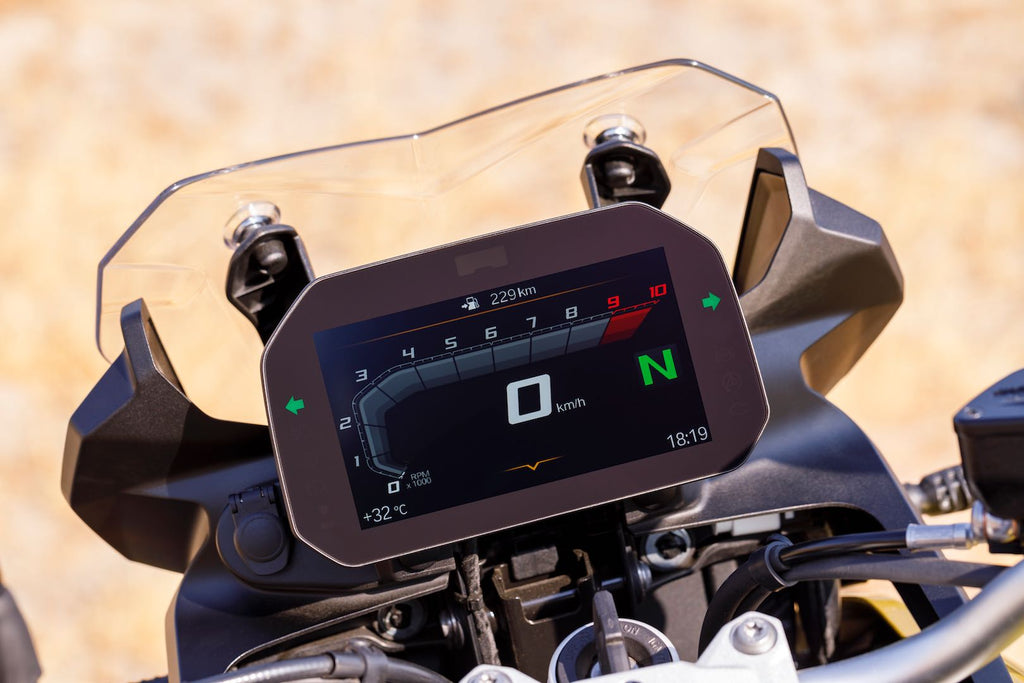BMW F 850 GS vs. F 800 GS: Was hat sich zum Besseren verändert?

BMW Motorrad schickt sich an, das gesamte ADV-Touring-Segment zu erobern - jetzt mit der neuen F 850 GS und F 850 GS Adventure, die für das Modelljahr 2019 neu gestaltet wurden.
Glauben Sie uns, wir verstehen das. BMW bietet eine Reihe hervorragender, schwergewichtiger Maschinen mit allem erdenklichen Schnickschnack an, wie zum Beispiel die alte R 1200 GS und die neue R 1250 GS. Dies sind die besten und einzigen Möglichkeiten, ADV zu fahren.
Well, not quite.
Die Kategorie der mittelschweren Abenteuermotorräder ist hochpotent und extrem unterhaltsam. Ein typisches Beispiel? Die Plattformen der BMW F 850 GS und GS Adventure, die jetzt mit einem komplett neuen Motor, Fahrwerk, Karosserie und elektronischem Fahrerassistenzsystem ausgestattet sind. Ein Mittelgewicht hat noch nie so stark ausgesehen...
Schauen wir uns die Details der F 850 GS und der F 850 GS Adventure an und weisen auf die wichtigsten Neuerungen der bisherigen F 800 GS hin. Sind die Verbesserungen den Hype wert?
Wir denken schon.
GROSSE Motoränderungen - BMW erhöht den Hubraum des 2019er F 850 GS und ändert die Zündfolge
Die Schlagzeilen bei der Vorstellung der F 850 GS und GS Adventure werden durch den vergrößerten Hubraum des flüssigkeitsgekühlten Parallel-Twin-Motors von BMW bestimmt.
Der zusätzliche Hubraum ist das Ergebnis einer Änderung der Grundarchitektur des Motors durch die deutschen Ingenieure. Während die Bohrung im Vergleich zur F 800 GS gleich bleibt, wurde der Hub von 75,6 mm auf 77 mm erhöht.

Infolgedessen steigt der Gesamthubraum um 55 cm³ auf 853 cm³.
Hier sind die Motor-Updates:
- 84 x 77 mm Bohrung und Hub
- Größerer 853ccm-Hubraum
- Aktualisierte und modellspezifische Kalibrierung
Neben der Vergrößerung des Hubraums hat sich BMW Motorrad auch auf die Verbesserung des Motorcharakters konzentriert, indem die 360-Grad-Zündfolge mit 0 Grad Kurbelwellenzapfenversatz durch eine 270-Grad-Zündfolge mit 90 Grad Zapfenversatz ersetzt wurde.
In Verbindung mit einem doppelten Gewichtsausgleich sorgt dies für ein butterweiches Fahrverhalten bei niedrigen bis mittleren Drehzahlen.
Ebenso stattete Motorrad die F 850 GS und GS A mit einem modellspezifischen Steuergerät aus, das die Kraftstoffeffizienz und das Ansprechverhalten der Drosselklappe verbessern soll, sowie mit speziellen Ein- und Auslassnockenwellen.
Je mehr Leistung, desto besser, oder?
Durch die Vergrößerung des Hubraums und eine Reihe fein abgestimmter Überarbeitungen wird die Leistung des neuen F 850 GS gesteigert.
BMW Motorrad behauptet, dass die neue mittelschwere GS eine Leistung von 80 PS bei 9.000 U/min und ein Drehmoment von 63 ft/lbs bei 6.250 U/min hat.
Sicher, eine R 1250 GS bringt zwar mehr Leistung, aber das sind nur 5 PS und 2 Pfund mehr Drehmoment als bei der bisherigen F 800.
Hier sind die Kurzstatistiken:
- Behauptete 80 PS bei 9.000 U/min
- Behauptetes Drehmoment von 63 Pound-feet bei 6.250 U/min
- Verbesserte Kraftstoffeffizienz
Leistungszahlen bedeuten jedoch nicht alles.
BMWs Änderungen an der mittelschweren GS konzentrierten sich darauf, eine besser nutzbare und freundlichere Leistungsentfaltung zu schaffen. Und genau das ist ihr gelungen.
Die anfängliche Leistungsentfaltung ist im Vergleich zum Vorgängermodell deutlich sanfter, und der zusätzliche Schwung durch einen kürzeren ersten und zweiten Gang reicht aus, um jedes Hindernis auf dem Weg zu überwinden. Ganz zu schweigen von der angeblichen Verbesserung des Kraftstoffverbrauchs. Gewinn, Gewinn.
BMW stattet die F 850 GS mit neuester Elektronik aus
BMW Motorrad ist bekannt dafür, die fortschrittlichsten und am besten verfeinerten elektronischen Fahrhilfen für ADV-Maschinen zu entwickeln, und die F 850 GS ist nicht anders. Jede einzelne Funktion der GS zielt darauf ab, ein angenehmeres Fahrerlebnis zu schaffen und gleichzeitig Sicherheit und Komfort zu verbessern.

Die F 850 GS wurde mit den richtigen Maximalwerten und den perfekten Minimalwerten gebaut, um Autobahnen, enge Waldwege und alles, was dazwischen liegt, zu erobern - und ist entsprechend mit elektronischen Funktionen ausgestattet. Zur Standardausstattung gehören zwei Fahrmodi (Regen und Straße) und die automatische Stabilitätskontrolle (ASC). Aber halt, da ist noch mehr...
Optionales Select-Paket
- Beheizte Griffe
- Tempomat
- Gepäckträger mit Satteltaschenhalterungen
- Ride Modes Pro
- Schaltassistent Pro
Die Ausstattung der F 850 GS verleiht ihr nicht nur zusätzliche On- und Offroad-Fähigkeiten, sondern macht die mittelschwere GS auch nahezu stufenlos einstellbar. Mit dem optionalen Premium-Paket erhalten Sie den Ride Mode Pro, der mit den Modi "Enduro" und "Enduro Pro" für noch mehr Offroad-Performance sorgt.
Eine einstellbare dynamische Traktionskontrolle und ABS Pro-Modi bieten ebenfalls Anpassungsmöglichkeiten an die Vorlieben des Fahrers.
Optionales Premium-Paket
Das Select-Paket ist serienmäßig, plus:
- LED-Beleuchtung
- Keyless Ride
- Tire Pressure Monitor
- Dynamische elektronische Fahrwerkseinstellung (ESA) oder niedrige Federung
Noch besser? Die dynamische elektronische Federungsanpassung (ESA) passt die Dämpfungseigenschaften automatisch an die Straßen- oder Trailbedingungen und den Fahrstil an. Und Gear Shift Assist Pro bietet nahtlose Hoch- und Herunterschaltvorgänge in jedem Gang. Tolles Zeug.
Die BMW F 850 GS schiebt Mittelgewichtler in Richtung ultimative Performance
Die 2019er BMW F 850 GS und GS Adventure sind der Beweis dafür, dass die mittelschwere ADV-Kategorie die Leistungsdefizite zu den schwergewichtigen Maschinen, wie der R 1250 GS, kontinuierlich aufholt.
Der zusätzliche Hubraum steigert die Gesamtleistung und sorgt gleichzeitig für eine fahrerfreundliche Leistungsentfaltung und Gasannahme. Die neuesten elektronischen Updates bringen diese GS auf Augenhöhe mit allen ADV-Motorrädern auf dem Markt.

2019 BMW F 850 GS Technische Daten:
Motor
- Hubraum: 853ccm
- Typ: luft-/flüssigkeitsgekühlter DOHC-Parallel-Twin
- Bohrung x Hub: 84,0 x 77,0 mm
- Verdichtungsverhältnis: 12,7:1
- Getriebe: 6-Gang
- Endantrieb: Kette
- Betankung: Elektronische Kraftstoffeinspritzung mit Ride-by-Wire
- Angegebene Leistung: 80 Pferdestärken bei 9.000 U/min
- Behauptetes Drehmoment: 63 pound-feet @ 6.250 rpm
Chassis/Maße
- Rahmen: Stahl-Monocoque-Rahmen mit Motor als tragendes Element
- Federung vorne: 43-mm-Gabel; 8 Zoll Federweg (9,1 Zoll/GS A)
- Hinterradaufhängung: Monostoßdämpfer, einstellbare Vorspannung; 8,6 Zoll Federweg (8,5 Zoll/GS A)
- Vorderrad: 2.15 x 21; Drahtspeiche quer
- Hinterrad: 4,25 x 17; Drahtspeichenkreuz
- Vorderreifen: 90/90 x 19
- Hinterreifen: 150/70 x 17
- Vordere Bremsen: Zwei schwimmend gelagerte 305-mm-Scheiben mit 2-Kolben-Bremssätteln
- Hinterradbremse: 265-mm-Scheibe, mit Einkolben-Schwimmsattel
- Neigung/Spur: 28°/4,9-in.
- Radstand: 62,7 Zoll.
- Leergewicht: 504 lb. (538 lb./GS A)
- Kraftstoffkapazität: 4 Gallonen (6,1 Gallonen GS A)